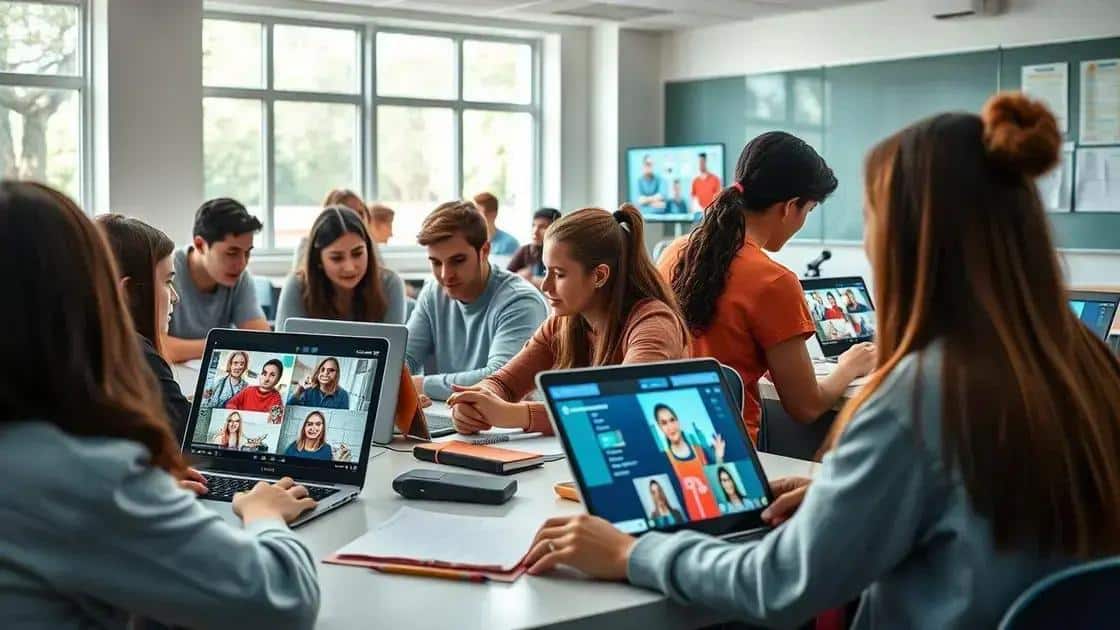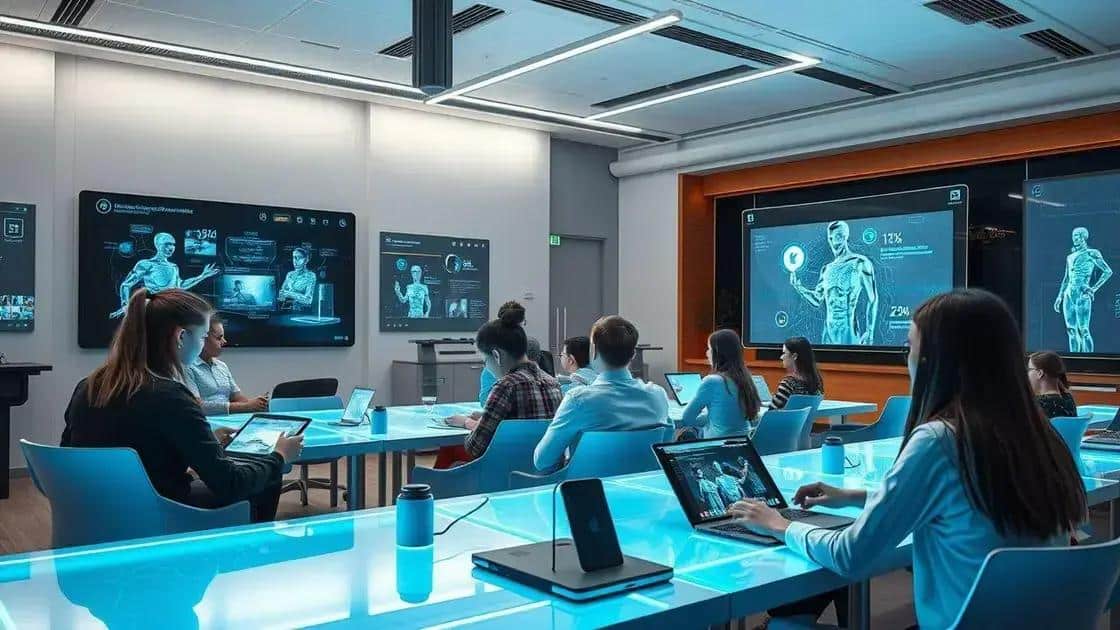Hybrid learning success trends to watch in 2024

Hybrid learning success trends combine online and face-to-face instruction, enhancing flexibility, engagement, and personalization in education, making it a key approach for diverse learning environments.
Hybrid learning success trends are reshaping how we think about education. Have you ever imagined a classroom that combines the best of online and in-person learning? Let’s explore how these trends are changing the way we learn.
Understanding hybrid learning models
Understanding hybrid learning models is essential for both educators and students. These models combine traditional classroom experiences with online learning, providing flexibility and accessibility.
There are various types of hybrid learning models. Each offers unique advantages that cater to different educational needs.
Types of Hybrid Learning Models
Let’s explore some popular styles:
- Flipped Classroom: Students learn new content at home and engage in discussions in class.
- Rotation Model: Students rotate between online and in-person classes, allowing for personalized pacing.
- Flexible Model: Students choose how they want to learn, switching between in-person and online as they prefer.
- Enriched Virtual Model: Mainly online learning is supplemented with occasional in-person meetings.
Each of these models has proven effective in enhancing student engagement. For example, the flipped classroom allows students to familiarize themselves with material outside the classroom, making in-class time more productive. Meanwhile, the rotation model helps accommodate students’ individual learning speeds.
Incorporating technology is crucial in hybrid learning. Digital tools enable seamless transitions between different learning environments. Tools like learning management systems (LMS) facilitate communication, assignment submissions, and feedback, creating an interactive environment.
Benefits of Understanding Hybrid Learning
By grasping various hybrid learning models, teachers can:
- Address diverse learning styles effectively.
- Enhance engagement and participation among students.
- Improve accessibility for students who may have difficulties attending traditional classes.
Ultimately, understanding these models prepares educators to implement strategies that reflect the evolving educational landscape. Hybrid learning represents a shift toward more tailored, student-centered education.
Key benefits of hybrid learning

Understanding the key benefits of hybrid learning can greatly impact how we approach education today. This model offers a blend of online and in-person experiences, designed to cater to diverse learners.
One major advantage is flexibility. Students can access materials and lessons on their own schedules, which can lead to a more personalized learning journey. This accessibility allows learners to manage their time more effectively, balancing academics with other commitments.
Enhanced Engagement
Hybrid learning also fosters greater engagement. When students have the option to participate both online and in person, they can choose the environment that works best for them. This choice often leads to increased motivation and participation.
- Interactive online tools keep students engaged with multimedia content.
- In-person sessions can focus on discussions and hands-on activities.
- Real-time feedback becomes easier through digital platforms.
Another benefit is improved accessibility. Students who may struggle with traditional classroom settings can thrive in a hybrid model. This approach allows for adjustments tailored to individual learning needs.
Personalized Learning Experiences
Furthermore, hybrid learning promotes personalized experiences. Teachers can track student progress through software, identifying areas where extra support is needed. With technology, educators can customize lessons to suit each student’s pace.
It also encourages collaboration among peers. In hybrid settings, students can work in groups during in-person sessions and collaborate online to complete assignments. This interaction enhances their social skills and helps build a sense of community.
Lastly, hybrid learning can lead to better preparedness for future careers. Students develop essential skills such as digital literacy and self-management, which are crucial in today’s job market. They learn to navigate online platforms and take responsibility for their learning outcomes.
Success stories in hybrid education
Success stories in hybrid education illustrate how this innovative approach transforms learning experiences. Many schools and institutions have adopted hybrid models, yielding impressive results that showcase their potential.
One notable example is a high school in California that implemented a hybrid learning model. By combining online and face-to-face instruction, they saw a significant increase in student engagement. Teachers reported that students felt more motivated to participate when they could choose when and how they learned.
Improved Academic Performance
Another success story comes from a college in Texas. They integrated hybrid courses into their curriculum, allowing students to attend classes online while balancing work commitments. As a result, many students improved their grades by having the flexibility to review materials at their own pace.
- Higher retention rates among students.
- Increased participation in discussions during live sessions.
- More opportunities for peer collaboration.
Furthermore, an elementary school in New York adopted hybrid learning during the pandemic. They utilized technology to keep students connected, even when learning remotely. This creative approach allowed teachers to maintain the curriculum and support students effectively, leading to minimal learning loss during challenging times.
Community Engagement
Success in hybrid education also revolves around community involvement. Many schools have partnered with local businesses to provide resources and support for students. These partnerships have enhanced learning opportunities, allowing students to apply their skills in real-world settings.
For example, a local library collaborated with a school to offer online tutoring sessions. This partnership provided additional academic support for students who needed extra help, ultimately contributing to their success.
Hybrid education fosters resilience and adaptability, qualities essential for the modern workforce. As these success stories demonstrate, a blended approach to learning not only meets diverse student needs but also prepares them for future challenges.
Future trends in hybrid learning

Future trends in hybrid learning indicate exciting developments as educators embrace technology and innovative methods. As more institutions recognize the value of this approach, we can expect several impactful trends to emerge.
One major trend is the integration of artificial intelligence (AI) into hybrid learning environments. AI can help tailor educational experiences to individual student needs, providing personalized feedback and resources. This technology supports teachers by analyzing data to optimize learning paths.
Increased Use of Learning Analytics
Learning analytics is another key trend. Institutions will harness data to track student performance and engagement in both online and in-person settings. By understanding these patterns, educators can improve their methods and create more effective learning activities.
- Identifying at-risk students sooner.
- Adjusting course materials based on student progress.
- Enhancing the overall educational experience.
Additionally, we will see a rise in hybrid collaboration tools. As students and teachers become accustomed to virtual interactions, platforms for seamless collaboration will evolve. These tools will enable real-time communication and group projects, regardless of location.
Focus on Lifelong Learning
Future trends will also reflect a shift toward lifelong learning. As job markets change rapidly, individuals will need to continually upgrade their skills. Hybrid learning models provide the flexibility needed for adults to balance work and education.
Moreover, more institutions will implement micro-credentialing programs. These short, focused courses will help learners acquire specific skills quickly, ensuring they remain competitive in their fields.
In conclusion, the future of hybrid learning looks promising. As technology advances and educational needs evolve, blended learning environments will become increasingly adaptable and effective, preparing students for the challenges ahead.
FAQ – Frequently Asked Questions about Hybrid Learning
What is hybrid learning?
Hybrid learning combines online and in-person instruction, allowing students to choose how they engage with their education.
What are the main benefits of hybrid learning?
The benefits include flexibility, increased engagement, personalized learning experiences, and improved access to resources.
How does technology enhance hybrid learning?
Technology provides tools for real-time collaboration, access to online materials, and learning analytics to track student progress.
Who can benefit from hybrid learning?
Anyone can benefit, including students seeking flexibility, working adults pursuing education, and educators looking to enhance their teaching methods.





